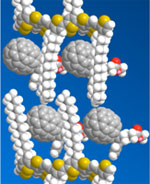Molecular Mixing in Organic Solar Cells
summary written by Raven Hanna
Solar panels contain a number of solar cells that convert light into electricity. Solar cells are traditionally made of crystalline silicon, which presently have 15-20% efficiency in conversion of light into electricity. However, these traditional cells are bulky and have high production costs that can take 5-7 years of solar panel operation to recover. Using solar cells made from organic materials could lower their production costs. This would lessen the time it takes for solar panels to generate more energy than consumed during production and would also result in more widespread application of solar energy.
The most common organic solar cell implementation has a polymer/fullerene bulk-heterojunction (BHJ) blend as the active (sunlight absorbing) layer. To form the BHJ, the polymer and fullerene (a buckyball) are blended and typically spontaneously self-assemble into the BHJ. It has remained a puzzle, however, why some polymerfullerene systems reach optimal efficiency at equal parts polymer and fullerene and other systems optimize at around 80% fullerene content.
To understand what causes this variation in efficiencies depending on the polymer molecule, scientists from SLAC and Stanford used Beam Lines 11-3, 2-1, and 7-2 for x-ray diffraction experiments to explore the materials at a molecular scale. They found that for some polymers the fullerene molecules intercalated (or co-crystallized) within the crystalline structure of the polymer provided there was enough space within the polymer. This was surprising, since the researchers were expecting to find two separate materials: the pure polymer and pure fullerene. The researchers found only the intercalated phase for BHJs made with equal parts polymer and fullerene. However, when the polymer:fullerene ratio was 1:4, two phases did form; one was the polymer-fullerene co-crystal and the other was pure fullerene. These results fully explain the dependence of efficiency on polymer:fullerene blend ratio.
This study is the first to find fullerene molecules intercalated within a polymer crystal. How this co-crystallization affects efficiency and whether it is a desirable trait remains to be seen. This and future knowledge gained from analyzing the structure of these materials will allow researchers to understand the reasons for the diverse behavior of different materials and to design more efficient materials. This work was published in the journal Advanced Functional Materials.
To learn more about this research see the full Scientific Highlight
"Bimolecular crystals of fullerenes in conjugated polymers and the implications of molecular mixing for solar cells", A.C. Mayer, M.F. Toney, S.R. Scully, J. Rivnay, C.J. Brabec, M. Scharber, M. Koppe, M. Heeney, I. McCulloch, M.D. McGehee, Adv. Func. Mater. 19, 1173-1179 (2009).


